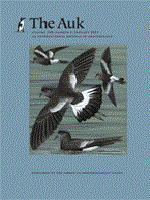The 2012 Ralph W. Schreiber Conservation Award is presented to Paul A. Johnsgard for his outstanding contributions to the conservation of the Great Plains of North America. Few living ornithologists have written as widely about birds, have been more instrumental in promoting awareness of birds generally and the Great Plains avifauna specifically, or have influenced the public more than Paul A. Johnsgard.
The Great Plains of North America is one of the most imperiled landscapes in the world. The birds that depend on these fragile habitats are being lost. Without the support of the public, policy-makers, local governments, and others, no conservation program can hope to be successful. This support can be garnered only through education, because people will conserve only what they understand and appreciate. Through his lifetime of writing, photography, drawing, lecturing, teaching, research, and television productions, Paul A. Johnsgard has tirelessly presented a message of how important it is to understand, appreciate, and conserve the birds of the Great Plains and their habitats. Hardly any ornithologist alive today has reached as many readers with the important message that nature is exciting and that our rich natural heritage must be preserved for future generations.
Following an M.S. at Washington State University, Paul completed Ph.D. training at Cornell University with Charles Sibley (having a major role in the development of Sibley's pioneering work on the use of egg-white proteins for avian taxonomy), and later did a postdoctoral fellowship at the Wildfowl Trust in the United Kingdom. Paul's initial scientific interests were in the evolutionary relationships among waterfowl species, with a later focus on the ethology of pair formation behavior, especially in Mallards and Black Ducks. He also did work on eiders and various little-known Australian and South American ducks.
Paul has been an eloquent spokesman for appreciation and preservation of the Great Plains throughout his career. Following his appointment as a faculty member at the University of Nebraska, Lincoln, the magnificent prairies and wetlands of the Great Plains kindled Paul's interest in prairie grouse, Sandhill Cranes, and Snow Geese. Paul authored three books, Song of the North Wind (1974), Those of the Gray Wind (1981), and Crane Music (1991), detailing the fascinating natural history of these species and conveying to non-scientists the majestic spectacle of their migration across the Great Plains. These books served to market the great spring migration along the Platte River and Rainwater Basins, promoting the conservation of these critically important staging areas.
Paul's books, The Platte: Channels in Time (1984), Prairie Children, Mountain Dreams (1985), This Fragile Land: A Natural History of the Nebraska Sandhills (1995), Earth, Water, and Sky: A Naturalist's Stories and Sketches (1999), The Nature of Nebraska (2001), Great Wildlife of the Great Plains (2003), Lewis and Clark on the Great Plains (2003), Faces of the Great Plains (2003), Prairie Dog Empire: A Saga of the Short-grass Prairie (2004), The Niobrara: A River Running through Time (2007), and Wind through the Buffalo Grass (2008), have served to enlighten the public about the grandeur of the prairie landscape and the intimate relationship of people with the prairie. Birds of the Great Plains (1979), Prairie Birds: Fragile Splendor in the Great Plains (2001), and Grassland Grouse and Their Conservation (2002) have raised awareness of these imperiled birds and the often forgotten landscape in which they live.
In addition to books written for the general public, Paul has written many frequently cited monographs, including Handbook of Waterfowl Behavior (1965), Animal Behavior (1967), Waterfowl: Their Biology and Natural History (1968), Waterfowl of North America (1975), The Bird Decoy (1976), Ducks, Geese, and Swans of the World (1978), A Guide to North American Waterfowl (1979), Waterfowl of North America (1987), Ducks in the Wild (1993), Ruddy Ducks and Other Stifftails (1996), Grouse and Quails of North America (1973), The Plovers, Sandpipers, and Snipes of the World (1981), The Grouse of the World (1983), The Cranes of the World (1983), The Quails, Partridges, and Francolins of the World (1988), The Hummingbirds of North America (1983, 1997), The Pheasants of the World (1986, 1999), Diving Birds of North America (1987), North American Owls (1988, 2002), Hawks, Eagles, and Falcons of North America (1990), Bustards, Hemipodes, and Sandgrouse: Birds of Dry Places (1991), Cormorants, Darters, and Pelicans of the World (1993), Arena Birds (1994), The Avian Brood Parasites (1997), and Trogons and Quetzals of the World (2002). Anyone undertaking studies of birds in the second half of the 20th century prior to the appearance of the Birds of North America series would have consulted Paul's books as the definitive starting point.
Paul A. Johnsgard embodies the concept of a distinguished senior scientist who has made important ornithological contributions to his discipline and reached out to wide audiences with the opportunity to learn about the natural world and to argue for its importance and preservation. Few ornithologists have influenced their colleagues and the general public to the extent that Paul A. Johnsgard has. The AOU is honored to award Paul A. Johnsgard the Ralph W. Schreiber Conservation Award for 2012.
Award criteria.—The Ralph W. Schreiber Conservation Award recognizes extraordinary scientific contributions to the conservation, restoration, or preservation of birds and/ or their habitats by an individual or small team (usually fewer than 10 people). Contributions from throughout the world and over any time course are eligible. Appropriate activities include (a) applied research, restoration, and educational actions that conserve birds or preserve significant bird habitats; (b) scientific examination of the principles of avian conservation and application of new insights into species restoration; and (c) scientific evaluation, guidance, creation, and oversight of avian recovery programs or habitat reserve-restoration programs. The award consists of a framed certificate and an honorarium.






